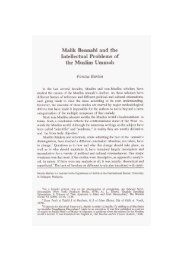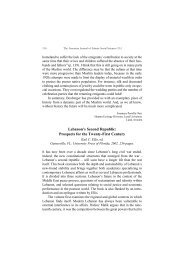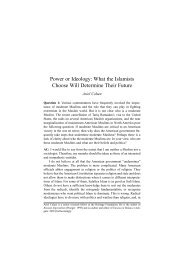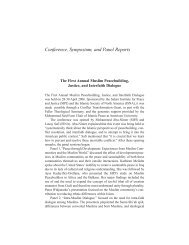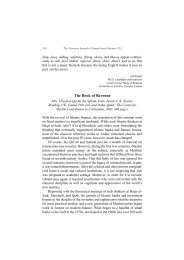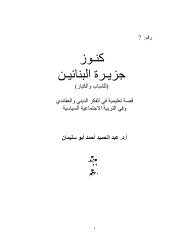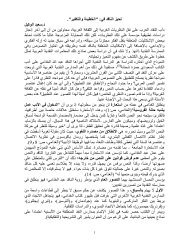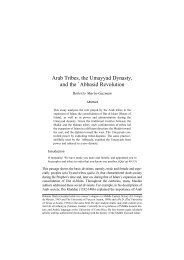Social Science's Need for a Cultural Symbols ... - Epistemology
Social Science's Need for a Cultural Symbols ... - Epistemology
Social Science's Need for a Cultural Symbols ... - Epistemology
Create successful ePaper yourself
Turn your PDF publications into a flip-book with our unique Google optimized e-Paper software.
Dhaouadi: <strong>Social</strong> Science’s <strong>Need</strong> <strong>for</strong> a <strong>Cultural</strong> <strong>Symbols</strong> Paradigm 19<br />
because of political and ideological differences between the political<br />
regimes. At times, things got even worse. Arab armies have fought each<br />
other on Arab land. Iraq’s invasion of Kuwait in 1990 and the military confrontation<br />
between Iraq, on the one hand and the U.S. led alliance, including<br />
the participation of several Arab armies, on the other, is considered to be the<br />
bloodiest confrontation between the armies of modern Arab states.<br />
In spite of that, religio-linguistic cultural solidarity tends to exist in<br />
some sort of immunity. This type of solidarity seems to have its own logic<br />
and rules. It appears to be only temporarily affected by such conflicts and<br />
confrontations. Religio-linguistic and cultural solidarity tends to dispose of<br />
considerable strength and power like a supernatural <strong>for</strong>ce. It is capable of<br />
minimizing the immediate costs of tragic worldly events and of outliving<br />
them.<br />
The common Islamic and linguistico-cultural symbols have enabled<br />
the Arab Muslims to preserve their religio-linguistic and cultural solidarity<br />
<strong>for</strong> over fourteen centuries. As stressed throughout this paper, the religio-linguistic<br />
and cultural ties are imbued by transcendental/metaphysical<br />
dimensions. Due to that nature, they are in a position to secure lasting<br />
bonds and alliances between social actors. The military, political and economic<br />
alliances between nations and people hardly ever achieve such continuous<br />
and lasting solidarity. 33<br />
Case Study II: Canada’s Syndrome of the Two Solitudes<br />
In Canada, Quebec’s desire <strong>for</strong> separation or <strong>for</strong> some sort of autonomy<br />
continues to create tension and conflict within the Canadian Federation.<br />
The numerous constitutional conferences which the federal government has<br />
held with the provincial ones have not yet succeeded in integrating Quebec<br />
as a distinct society in the larger Canadian society. 34 The concept of “distinctiveness”<br />
which Quebec seeks to legislate into the Canadian constitution<br />
pertains essentially to Quebec’s cultural dimensions that distinguish it<br />
from the rest of the Canadian provinces. The majority of Quebec’s population<br />
speaks French and belongs to a rather French culture. In the vast North<br />
American Anglophone linguistico-cultural space, Quebec remains and perceives<br />
itself as a Francophone identity.<br />
Quebec’s call <strong>for</strong> sovereignty is no longer the strict slogan only of the<br />
Separatist Party Quebecois. Recently, to a certain degree, it also has become<br />
the theme of discussion of Quebec’s Liberal Party which was in power. 35<br />
And this was in spite of its well-known federalist sympathy and alliance.



